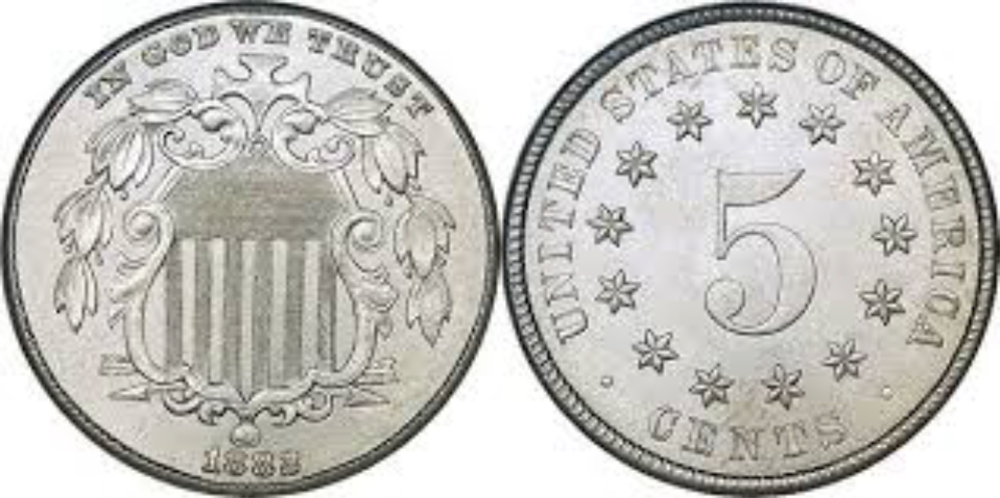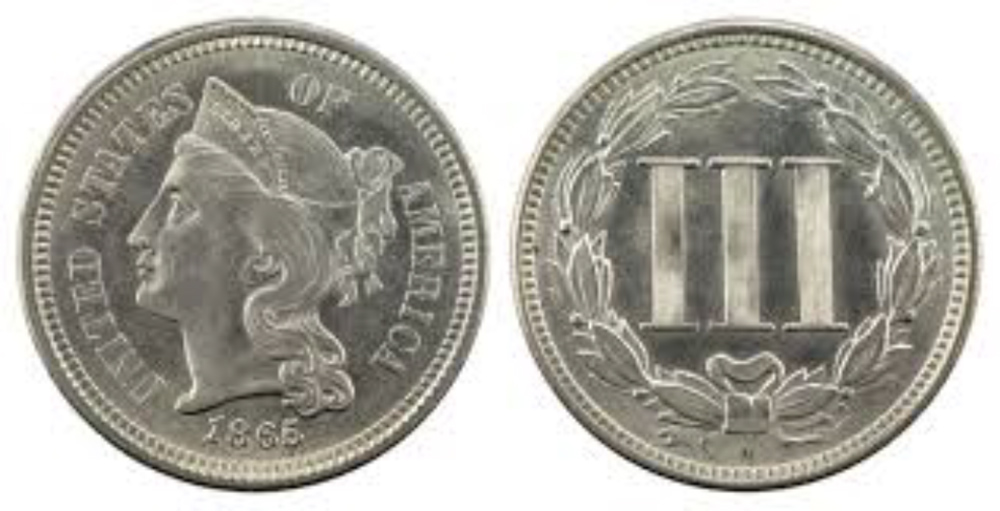Shore Collectibles
By Douglas Keefe
I feel strongly that the Civil War had the greatest effect on our monetary system ever, from validating paper money by requiring banks to obtain a Federal charter and adhere to their requirements in order to issue paper money and issuing paper money explicitly backed by gold and silver, to changes in the size, metallic content and issuance of new denomination of coins. The two-cent coin I wrote about last week is an example of a new denomination, and the change in our one cent coin from containing 88% copper and 12% nickel to 95% copper and 5% zinc and tin is another.
Well, the elimination of nickel in the one cent coin did not go over well with the nickel mine owners, who were vocal about lost revenue and job losses to their elected officials (some things never change). The result of their lobbying was the creation of 2 new coins, a three-cent coin and a different five cent coin.
The three-cent coin was not a new denomination but was different in metallic composition. The three-cent coin was first struck in 1851 in part due to the rate to mail a letter dropped to three cents and was the first coin not to contain its’ value in a precious metal. Instead of being 90% silver like the other silver coins, it contained only 75% silver. This was to discourage hoarding and melting of silver coins going on at the time due to the fact the value of the silver content in the other coins exceeded the face value, a problem inherent when a coin is made with a precious metal whose price fluctuates. This was finally addressed by the United States Mint in 1964 and 1970 when the mint stopped using silver in circulating coinage.
Getting back to the new three cent coin, it was first struck in 1865 near the end of the Civil War and was a replacement for the silver three cent silver coin, which was also being hoarded along with the higher denomination coinage. The new coin contained 25% nickel, putting the mint back in the business of buying nickel, and 75% copper, resulting in a grayish color to the coin. Mintage figures were in the millions until 1871 when they slowly declined to 1876 after which from 1877 to 1879 they were struck in proof condition only for collectors. In 1880 circulation strike coins were minted along with proof issues and continued until 1889, however, the circulation strike mintage figure for these years are exceptionally low, in one case of the year 1885, only one thousand were made. Because of the extremely low mintage figures for the years in the 1880’s, for collectors, this is a difficult and expensive set to complete.

The next coin to debut was the five-cent coin in 1866, also containing 25% nickel and 75% copper (those mine owners must have twisted the politicians’ arms, or wallets). There was currently a coin worth five cents, it was a silver half dime which contained half the silver as a dime and was also hoarded. This new coin ultimately replaced the half dime permanently by 1873 and, unlike the two and three cent coins, is still in production and use today.
An interesting result of the silver half dime and the nickel five cent coin circulating together was that people would refer to the five cent coin as that nickel coin, abbreviated to that nickel, which it is still referred to today, not a five cent coin.
Douglas Keefe is the President of Beachcomber Coins, Inc. He and his wife Linda operate Beachcomber Coins and Collectibles, formally located in the Shore Mall and now located at 6692 Black Horse Pike, Egg Harbor Township in the old Wawa building. They also have satellite offices for buying only in Brigantine (Saturday), and in Absecon (Tuesday). Between them, they have over 70 years of experience buying and selling coins, collectibles in precious metals. They are members of the American Numismatic Association, the Industry Council of Tangible Assets, the Numismatic Guarantee Corporation, the Certified Coin Exchange and the Professional Coin Grading Service. Visit their website at www.beachcombercoinsinc.com for video and information.






